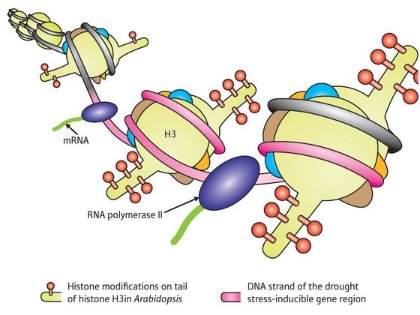Dec. 26, 2008 Research Highlight Biology
The molecular machinery of drought response
Regulating the response to dehydration in plants is a dynamic process that occurs at the molecular level
 Figure 1: Histone H3 modifications change dynamically throughout the transcription process on drought stress-inducible gene regions in Arabidopsis. As the molecular machinery of gene transcription, including RNA polymerase II, moves downstream along the DNA strand, the modified histone H3 tails influence gene transcription—even after the process has already begun.
Figure 1: Histone H3 modifications change dynamically throughout the transcription process on drought stress-inducible gene regions in Arabidopsis. As the molecular machinery of gene transcription, including RNA polymerase II, moves downstream along the DNA strand, the modified histone H3 tails influence gene transcription—even after the process has already begun.
New work by researchers from RIKEN in Japan has demonstrated the dynamic process of controlling stress responses in plants. To survive, plants must react quickly to environmental hazards such as drought, cold and salt. Stress responses are genetically controlled and require complex molecular machinery to regulate their timeliness and intensity.
The machinery is composed, in part, of protein spools around which DNA winds to keep the double strands of genetic information stable and compact. These spools are formed from histone proteins and their close association with genes on the DNA strand enables them to influence and regulate genetic activity. Histones can be targeted by functional molecules that attach to their tail-ends and this modification process is a key step in the genetic regulation of abiotic stress responses. Several genes that are switched on by drought stress have been identified in previous studies of the model plant Arabidopsis thaliana.
Motoaki Seki from the RIKEN Plant Science Center in Yokohama and his team have now revealed how some of these drought-inducible genes are regulated by histone modification under conditions of drought stress by use of chromatin immunoprecipitation (ChIP), a method that allows purification of protein-DNA complexes1.
Having focused their research on four drought-inducible genes, Seki and colleagues determined that the activation of some of these genes in Arabidopsis was associated with modifications to histones H3 that are associated with these particular genes. They noted increases in the attachment of two types of functional molecule to target sites on the H3 proteins. In particular, one type of histone modification occurred after an increase in gene transcription, the process of copying DNA to RNA by the enzyme RNA polymerase II (Fig. 1). This indicates that the process of histone modification is dynamic and changes throughout the period during which the molecular machinery is active.
This research boosts the understanding of the transcriptional regulatory gene network under drought stress in plants. It will also help to build our knowledge of plan responses to other environmental stressors. The findings are, says Seki, vital not only to the understanding of molecular response mechanisms but also to allow genetic engineering to improve the stress tolerance of crop plants.
The researchers “intend to identify the key sites of histone modification and key histone modification enzymes involved in the drought stress response,” says Seki. They will also explore the role of histone modification in the memory of stress perception in plants.
References
- 1. Kim, J.-M., To, T. K., Ishida, J., Morosawa, T., Kawashima, M., Matsui, A., Toyoda, T., Kimura, H., Shinozaki, K. & Seki, M. Alterations of lysine modifications on histone H3 N-tail under drought stress conditions in Arabidopsis thaliana. Plant and Cell Physiology 49, 1580–1588 (2008). doi: 10.1093/pcp/pcn133
